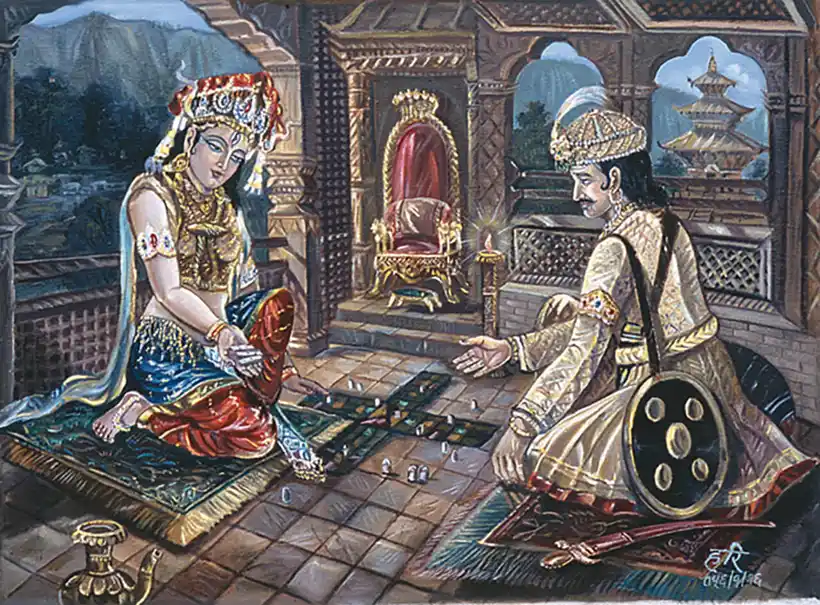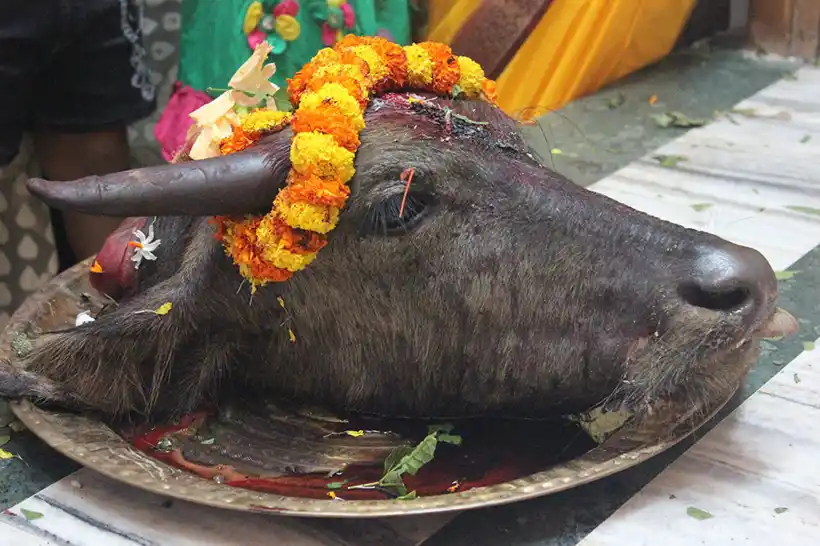
The practise of worshipping a selected virgin as a manifestation of the holy female spirit or devi is known as Kumari, Kumari Devi, or Living Durga in Nepal. The Kumari or Kumari Goddess is the only living goddess worshipped by Hindus and Buddhists. The literal meaning of Kumari is “Virgin”. The Kumaris are young, pre-pubescent girls who receive the power of Goddess Kali and Taleju. The Kumari Goddess is the living incarnation of Goddess Taleju. Kumari is the human embodiment of Goddess Taleju and symbolises power and protection.
How and when did the Kumari Puja tradition start?
You can read various tales of Kumari Puja in Nepal. The most well-known and widely accepted story is that of Jay Prakash.
The first tale is of Jaya Prakash Malla, the last king of the Malla Dynasty. According to the legend, Goddess Taleju visited Jaya Prakash Malla’s chambers during night time as a beautiful woman. They would play Tripasa (a dice game). The goddess visited the king’s chamber every night on the condition that the king refrain from speaking about their meetings to anyone.

One fateful evening, the king’s wife followed him to his chambers and inspected his secret meetings with the goddess Taleju. The goddess became aware of the king’s wife and left furiously. Goddess Taleju told Jaya Prakash in his dream that she would reincarnate as a living goddess in children among the Shakya and Bajracharya communities of Ratnawali. In his attempt to make amends with Goddess Taleju, Jaya Prakash Malla searched for children possessed by Taleju’s spirit and hence started the Kumari Goddess tradition. Jaya Prakash also built a house for Kumari to stay in near the palace and named it “Kumari Ghar.
A second myth about the origin of the Kumari Goddess circles around King Trailokya. According to legend, Goddess Taleju and King Trailokya played Tripasa every night and discussed the welfare of the country. One night, Trailokya made sexual advances towards the Goddess and infuriated her. As punishment, the Goddess stopped visiting the king’s place. Trailokya worshipped and pleaded for her return. Later, Godess Taleju agreed to appear in the body of a virgin girl from the Shakya family. Hence, the Kumari Goddess cult was established.
How is living goddess selected?
Finding a living goddess is a highly intensive process with many requirements. The selection ceremony for Kumari is supervised by five senior Buddhist Bajracharya, the Chief Royal Priest, a Priest of Taleju, and a royal astrologer. Sound health, the presence of visible scars and bruises on the body, uncut and imperfect body skin, premenstrual symptoms, and the absence of tooth loss are some of the important elements that are looked for in children.
Once the candidate has been chosen by the priests, she must go through additional, demanding tests to make sure she really does have what it takes to be Durga’s living body. For instance, during the Dashain festival at the Telaju Temple, a young girl is let loose into the courtyard where the heads of 108 slaughtered buffalo and goats are strewn about while individuals wearing hideous demon masks dance and stalk the child. The girl is put to the test to see if she shows fear in this circumstance. She will be boycotted and another Kumari will be chosen using the same method if she is afraid.

If she passes this test, her final test will require her to select the previous Kumari’s personal effects. She would then be accepted as the goddess Durga’s incarnation and brought to the Kumari Ghar as the living goddess Kumari, where she remained until the onset of her first period. After that, the same Kumari Goddess will select a new Kumari.
Life after the living goddess
A girl’s life completely changes after being chosen as a Kumari. She won’t leave her palace except for formal occasions; her family won’t often pay formal visits; and her playmates will be members of the caretaker’s family. The fire eye is painted on the forehead of the Kumari, who always wears red clothing and topknotted hair.

The last time the Kumari’s feet touch the ground before the Goddess Taleju departs from her body is during her walk around the Durbar Square. The President and Prime Minister bowed to Kumari and asked for her blessing. When visiting outside the palace, the Kumari is accompanied by her golden palanquin.
It’s said that catching a Kumari’s eye will bring good fortune. Many people come to the courtyard in front of Kumari’s window to see the living goddess. The Kumari’s rooms are visited by the wealthy and well-connected. She occupies a seat made of golden brass. People who are sick or have menstrual problems frequently see her. It is thought that Kumari holds specific abilities to treat such illnesses. High-ranking government officials and businessmen also go to see the Kumari Goddess. The live goddess is closely watched during the visit since her acts are said to represent a forecast of the visitor’s future.
Some actions and its meaning of Living Goddess are:
- Crying or loud laughter: serious illness or death
- Rubbing Eyes: Death is Approaching
- Shaking in fear: imprisonment
- Ignoring the food being offered: Losses in money
Kumari replacement process
The royal life of Kumari doesn’t last a lifetime. At a certain age when the Kumari reaches puberty and gets her first menstrual cycle, she is dethroned and then replaced by another young pre-pubescent girl. It is believed that when her first menstrual cycle begins, the deity leaves her body. For her dethroning process, she goes through one last ritual as a Kumari, done by the royal priest.
Return to ordinary life
After the Kumari is enthroned, she must be worshipped as Goddess for four days at her home by family members before she can resume her normal life. She is not a goddess anymore, so she can walk on her feet, share food, her friend’s circle is not limited anymore, and many more. After her journey as a Kumari ends, she is treated as a normal child. It may take some time to cope with the new environment, which might be quite challenging for the ex-Kumari. Every month after she is replaced, she receives a pension as a token from the government.

Everyone’s question is, Can a Kumari marry?
Yes, breaking the stereotype of the answer to the question, Kumari can get married. There is a misconception and myth about whether the former Kumari can get married or not. There is a myth that if former Kumari gets married, her husband will die shortly after their marriage. Another rumour is that the horoscope of the Kumari is too strong, which will affect their marriage and cause complications. There is no evidence of these statements to this date.
Almost all the former Kumaris are happily married with no indication of complications. And surprisingly, none of them or their husbands died shortly after their marriage. According to one of the former Kumaris, it’s just a myth and has no connection with their marital life. In several interviews, you can find testimonies given by the former Kumaris about their marital life.



